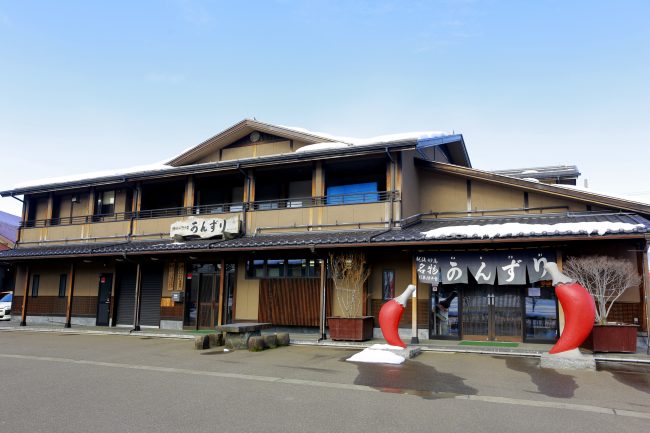Kanzuri: Aged Chili Paste from Niigata’s Snowy Tradition
Mar 05,2020
Kanzuri: Aged Chili Paste from Niigata’s Snowy Tradition
Mar 05,2020
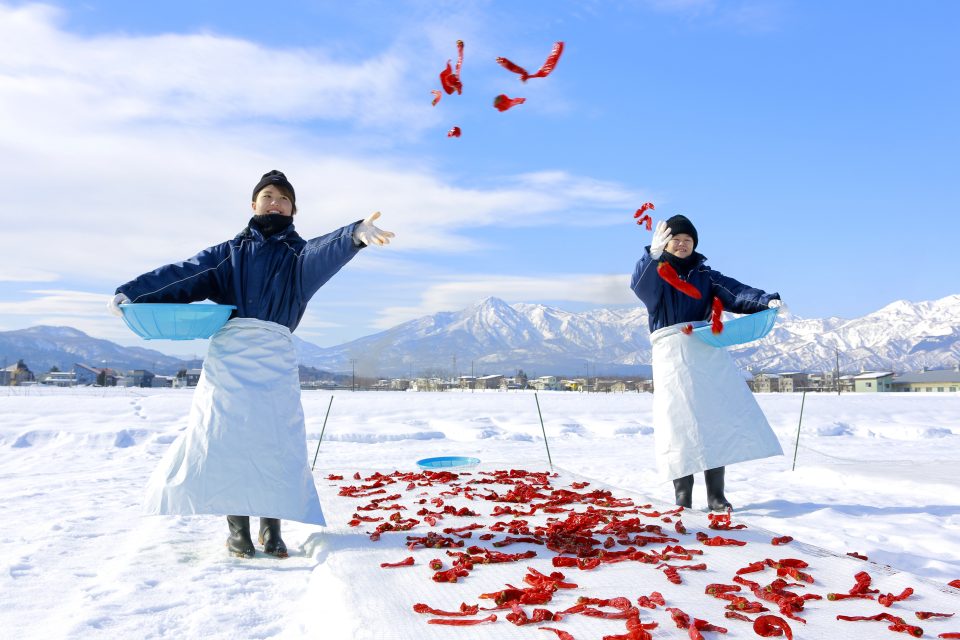

Have you heard of the seasoning with the unconventional name kanzuri? Kanzuri is a fermented chili seasoning that has been passed down for generations in the Niigata city of Myoko (formerly Arai). Its bright red appearance suggests it has a spicy flavor, but, in fact, it has a distinctive and complex taste of sweetness and sourness that develops over three years of careful fermentation. At the start of the coldest season of each year, a traditional process called yukisarashi takes place in which salted chili peppers are laid out on the snow. We visited the area on a clear winter day, when the Myoko mountain range stood out sharply against the blue sky.
“This year, we didn’t have much snow cover. But thankfully we finally got enough to do yukisarashi. We are going to start the process now in a corner of a rice paddy behind the store. Let’s go watch them.”
Relating this story is Shimizu Mayumi from Kanzuri Co., Ltd., the manufacturer of kanzuri. The characters for kanzuri literally mean “produced in a cold village”. The secret to the depth of kanzuri’s flavor — which seems to defy the simplicity of its ingredient list: chili peppers, koji malt, yuzu citrus, and salt — is the yukisarashi process, which is done before a long aging and fermentation process.
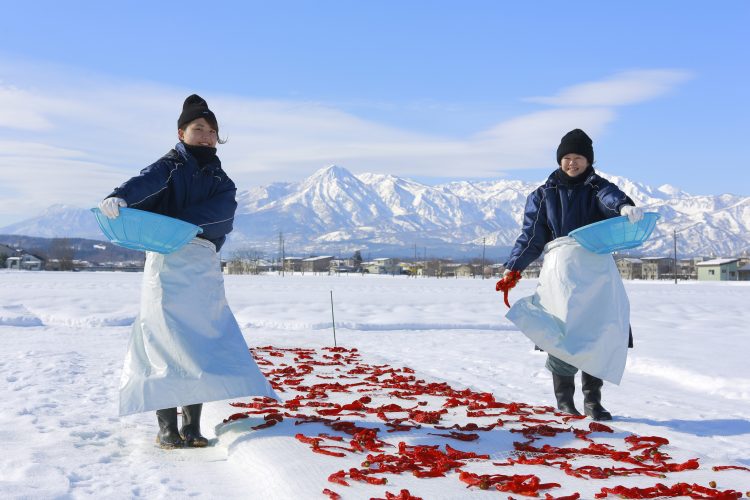
“Yukisarashi involves laying out chili peppers that have been soaking in salt since the fall on the snow starting on the coldest day in January. We leave the chili peppers laid out on the snow for three to four days while watching the weather and the condition of the snow. In the old days, every household made their own kanzuri. People say the practice of yukisarashi got started after someone happened to eat a chili pepper that had fallen on the snow after being hung from the eaves to dry. The person discovered the chili pepper had become more delicious, as it was sweeter with less saltiness and bitterness. It’s not the case that the longer you leave the chilies on the snow the better. People in the past found that leaving them on the snow for three to four days is just right.”
Telling us this is Sato, who is in his eighth year of working in kanzuri production. As a local, he has long been familiar with kanzuri since early childhood.
The barrels containing the salted chili peppers weigh about 350 kilograms. Every winter, the yukisarashi process takes about 20 days to complete, depending on the weather. This year little snow has accumulated on the ground, making the process more challenging than usual. Today, with a good snowfall and clear skies, it is a fine day for yukisarashi.

The trick is to toss the chili peppers upwards so they scatter evenly on the snow
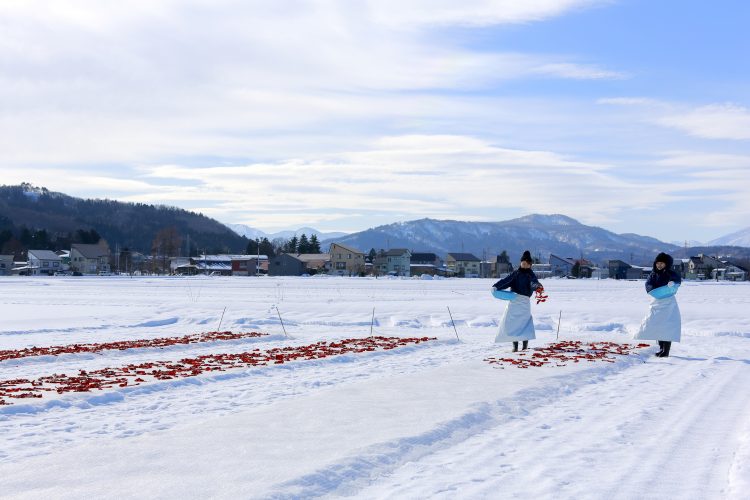
Women usually do the scattering of the chili peppers. With each toss, Miyazaki (left) chants “May you become delicious”.

The red chilies look striking against the pure white snow
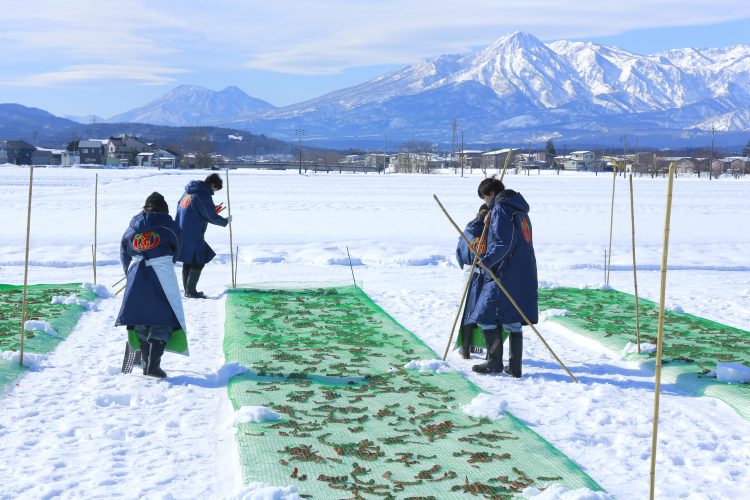
The chili peppers are quickly laid out, and the day’s work is done in seemingly no time at all. The final step is to place nets over the chili peppers and pin them down to ensure the chilies don’t blow away.
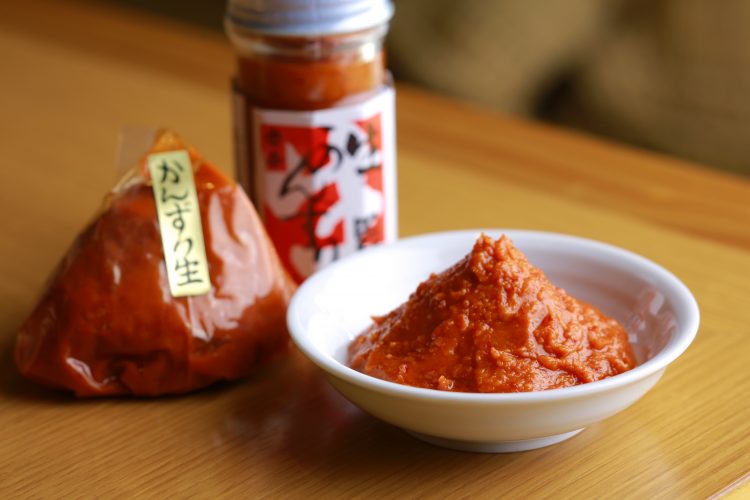
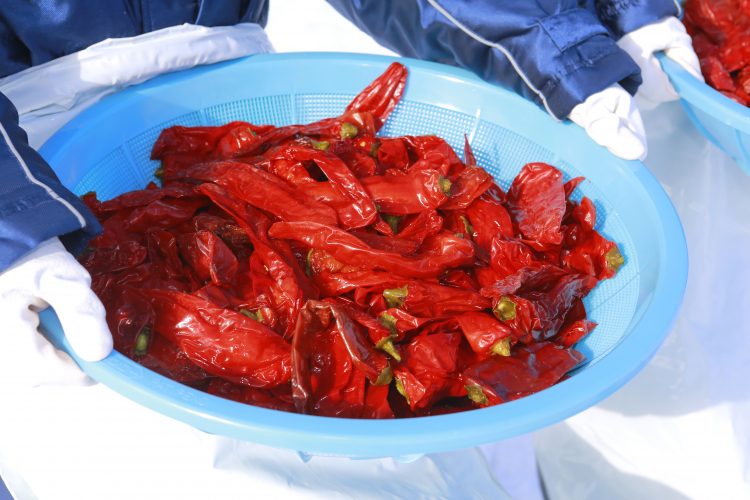
The ingredients for kanzuri are locally produced chili peppers, koji, yuzu, and salt. The most distinctive thing is the size of the chilies used for kanzuri.
Sato describes the chili peppers. “The kanzuri chili peppers we use are specially grown, either on our own farm or on contract farms in Myoko. They grow so large because we select seeds from the largest peppers of the year and plant those seeds to grow the following year’s crop.”
The chili pepper seedlings, which start to grow in the spring, reach their full height by the end of summer and are harvested in the fall. Since the peppers will rot easily if damaged, each chili pepper is picked individually by hand. The harvested chili peppers are cleaned with water, sorted to remove those with insects and damage, and then salted with natural sea salt. The chili peppers, which have been soaked in salt for four to five months, undergo yukisarashi in January, during the coldest part of the year when the ground is covered in snow.
Once the chili peppers have undergone yukisarashi, all the ingredients are arranged and the actual preparations can finally begin.
The chili peppers are mixed with koji, yuzu, and salt, then packed into barrels and left to mature. The aging process takes a minimum of three years, and can take up to six years.
During this time, a process called tegaeshi — turning each barrel upside down — is performed once a year to promote the fermentation. The finishing touch is kansarashi, where the barrels are placed outside in the cold to solidify the final flavor.
Shimizu describes the differences between aging durations. “Even with exactly the same ingredients, the taste after aging three years and after aging six years is considerably different. It’s a matter of personal preference as to which is better, but the kanzuri aged six years is certainly milder than the three-year-old kanzuri. Recently, our raw kanzuri taken directly from the barrels without heating has proven to be popular among restaurant chefs and owners.”

Shimizu told us many interesting stories at Kanzuri Co., Ltd.’s retail outlet
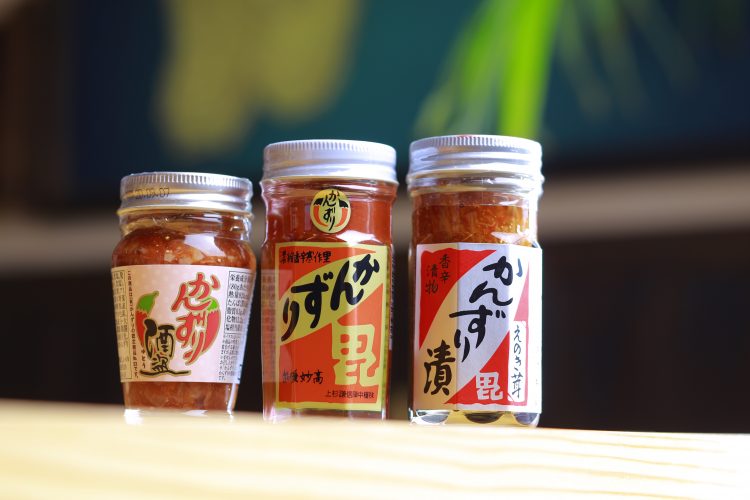
The company has expanded into various kanzuri-based products
Kanzuri has a long history, and there is a local legend that the Uesugi army used kanzuri during the Sengoku period (1467 to 1615) to keep soldiers warm in the cold and prevent frostbite. Despite being produced for over 400 years, kanzuri gradually faded from prominence with the passage of time. In 1966, the founder, Tojo Kuniji, and his son and current president, Kuniaki, established Kanzuri Co., Ltd. with the aim of preserving this traditional food for future generations. Since then, they have continued to uphold traditional manufacturing methods while also experimenting with new product development.
Shimizu outlines some of their innovations. “Products with enoki mushrooms, edible wild plants, and perilla seeds are popular because they can be enjoyed simply by adding a small spoonful over rice. Basic kanzuri is more than a spice; it can be mixed with mayonnaise to make a sauce, added to gyoza dumpling fillings, or used as the perfect hidden ingredient in a carbonara sauce. For New Year’s, I made a mochi [rice cake] pizza by spreading some kanzuri on mochi and topping it with sausage, bell peppers, and cheese. It was a hit with the kids.”
It’s surprising how well kanzuri goes with any kind of food, whether Japanese, Western, or Chinese. We asked the staff members who demonstrated the yukisarashi process for their recommended ways to have kanzuri.
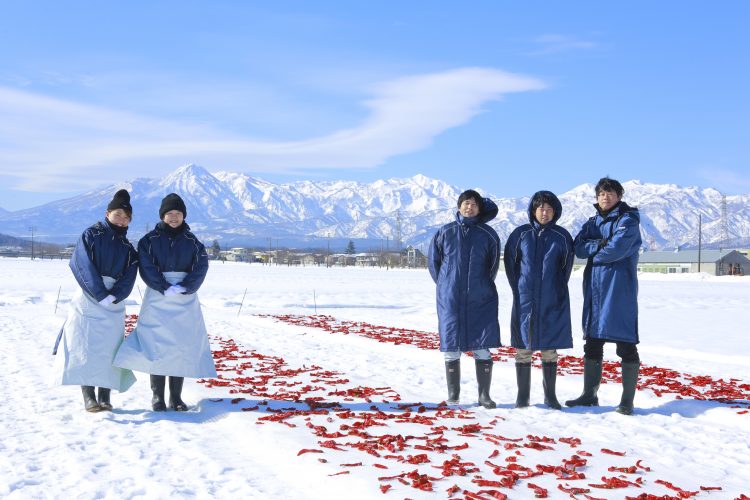
From the left,
“I recommend trying kanzuri in pork miso soup or hotpots” (Miyazaki)
“It’s delicious on grilled chicken” (Ueno)
“It tastes great with any kind of meat” (Iwasawa)
“I can’t have a hotpot without it” (Sato)
“Kanzuri goes perfectly with pork miso soup” (Mori)
With a 400-year history, the traditional kanzuri seasoning is a versatile spice that enriches any and all dishes.
Definitely give it a try for yourself.
